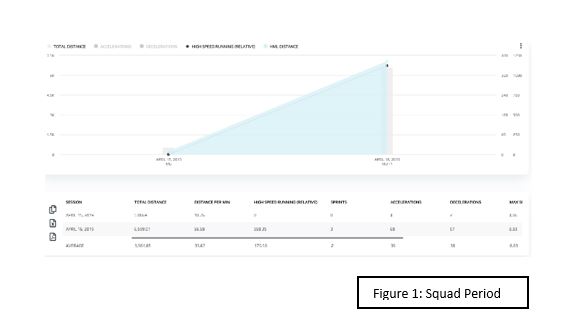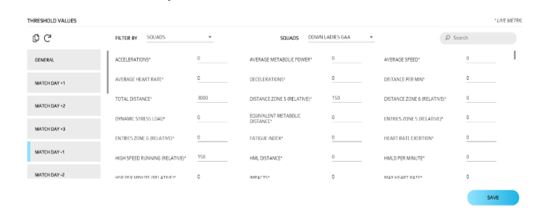
16 Jul A Sport Scientist’s guide to understanding and applying Thresholds in Sonra
Introduction
Game demands and training practices in team sports have changed considerably over recent decades, including the requirement of the coaching staff to effectively control, manipulate and monitor training loads (1).
To increase the chances of success, coaches must challenge the boundaries of what the players can achieve without exceeding what their bodies can tolerate. Hence, an appropriate balance between training, competition, and recovery is required to achieve optimal performance and injury avoidance (2).
This has led to a scientific approach when planning training loads, and GPS (Global Positioning System) / GNSS (Global Navigation Satellite System) tracking allows for quantification of these demands, and the use of thresholds is a crucial part of planning ahead and ensuring these demands are met.
Daily monitoring of a player’s workload has become crucial, and GPS technology has provided coaches/sport scientists with the necessary tools to quantify the physical demands of their sport, meaning they can make decisions based off objective data rather than previous experiences and subjective opinions (3).
The use of STATSports’ Sonra software allows both coaches and practitioners to monitor players training to effectively manage player conditioning levels and prevent injuries by exposing athletes to the right amount of training on the right days.
The use of thresholds is an effective method of ensuring your athletes are exposed to the correct amount of training leading up to match day (MD) and allowing you to make real-time decisions based on these workloads.
Implementing into Daily Practice
Within the STATSports’ Sonra system, there is the option to pre-set these thresholds and to monitor these both post session and in real-time using the Sonra Live iPad app; which allows the coach to collect data and to make real-time decisions based on what has been planned for that given day.
By taking the time and setting thresholds, this will help prevent the risk of over/under training the athlete, reducing the risk of injury (2).
To use thresholds effectively, it is vital to collect adequate data for your squad to really understand what load your athletes have been exposed to each day.
In the Sonra software, working back from a MD, sessions types are named in the calendar accordingly, Match Day (MD), Match Day Minus 1 (MD-1), Match Day Plus 1 (MD+1).
Practical Applications
A useful tool within Sonra to determine what thresholds to set for each day is “Squad Period”. This feature will allow you to examine the average workload for an accumulated session type which will then allow you to see a trend in that certain session.
For instance, if we select the past five MD-1 sessions and analyse the data using Squad Period this will provide the user with an average value for each metric that may be used as their MD-1 threshold going forward. This can be done for each session type; therefore, you can set out your weekly load.

The user will have several options when applying thresholds such as, setting an overall Squad threshold where all players work towards the same workload for that day, a Group threshold that could be applied to positional groups i.e. defenders, midfielders, and attackers.
Group thresholds are beneficial when attempting to control for the different physical demands required on a MD for players in different positions or alternatively for a Rehab group performing a modified session.
The last form of thresholds are Individual thresholds which would be based off what that individual is capable of doing in each session type based on his/her previous data – making the threshold relative to the individual athlete.
This is also fully adjustable which allows you to focus on the key metrics that is of interest to the user as you can set thresholds for over 100 metrics for every session type.

| Figure 2: Applying Thresholds
|
Once these thresholds are in place, a sync to the iPad is required to capture live data while viewing these specific thresholds. This process is required only once.
Within the iPad, there is an option to select session types which will determine which thresholds are set for that given day. When thresholds are tagged on the iPad, the bar graph will use a traffic light system to determine if the session is too intense, in an optimal range or not intense enough.
The user will also have the option to view the thresholds in a table format which will show the current figures relative to the athletes planned daily load for that day.
This traffic light system is adjustable in the Sonra software; therefore, the user has full control of what they want to indicate as Excessive or Below Optimal.
This approach is clear and concise making the Apex system user-friendly while giving the user full control to customise what they would like to implement for their own use.

Practical Considerations
The Session Type labelling approach has one significant limitation that occurs when a team must play multiple MD’s in a week due to the involvement in numerous competitions (i.e. domestic league/cup competitions and European competitions).
Therefore, these MD build ups may expose different loads due to the amount of time for recovery/work (4). For example, the planned workload for a MD+2 session in a week where a club has one game will be vastly different in a week where a club has 2 games per week as in this scenario a MD+2 might also be a MD-1.
For this reason, it is vital that best practice is maintained when applying the use of thresholds to your day-to-day workflow and that operational definitions are detailed early before the process is put into place.
Recent developments in the Sonra software has allowed the user to customise the Session Type names which should ease the initial application of thresholds and the aforementioned limitation.
References
(1) Henderson B et, al. (2015) ‘Game and Training Load Differences in Elite Junior Australian Football Journal of Sports Science and Medicine 14 (1), pp. 494-500.
(2) Scott BR. et, al. (2014) ‘The Physical demands of professional soccer players during in-season field-based training and match-play,’ J Aust Strength Cond, 22(), pp. 7-14.
(3) Gabbett TJ. The training-injury prevention paradox: should athletes be training smarter and harder? Br J Sports Med 2016; 50:273–80
(4) Anderson L. et, al. (2015) ‘Journal of Sports Sciences’, Quantification of training load during one-, two and three-game week schedules in professional soccer players from the English Premier League: implications for carbohydrate periodisation, (121), pp. 3.
Author Details
Stephen Bradley
Sport Scientist l Sport Science Dept.